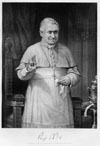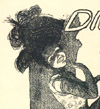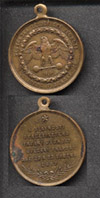| |
Social Science 217
Tues., Thurs., 2:00-3:20
FPH 101
Jim Wald, 559.5592
Off.
Hrs. G-15 FPH (sign-up)
Mon., Thurs. 12:00-2:00
Wed. 12:00-1:00
(and by appointment)
|
 course
description
course
description
 course
requirements
course
requirements
 reading
list
reading
list
|
•
|
syllabus
and course guide
|
announcements
announcement
text will follow as needed
|
course
description
|
The
"long" 19th century, stretching roughly from the political
ascendancy of Napoleon Bonaparte to the outbreak of the First
World War, was one of drama and contradictions. Europe was
rocked by revolutions, and yet it attained unprecedented prosperity
and secured its hold over colonial empires. New categories
and loyalties arose: the nation began to supplant the dynasty,
and ties between individuals were increasingly based on market
relations rather than traditional obligation. Capitalists
and socialists alike declared their faith in the power of
industry, science, and progress. It was in every sense the
century of both Darwin and Marx.
Course
goals:
To provide students with a foundation in history, which should
prove pertinent to a wide variety of pursuits in the social
sciences, humanities, and cultural studies. Many of our institutions,
world views, and social and symbolic practices arose in the
ninteenth century. Unless one understands that world, one
cannot really hope to understand the present.
Students will gain not only a solid grasp of principal events,
social movements, and intellectual currents, but also an introduction
to the historiography of the era. That is, they will come
to locate their understanding of the past in the context of
traditions of interpretation. (For example: How has our thinking
about the causes and con-sequences of the Revolutions of 1848
evolved? How have subsequent generations appropriated history
for their own purposes?)
|
course
requirements
|
•
regular attendance
• participation in classroom and web-based discussion
• one or more oral presentations
written
work (tentative):
•
several short essays and/or source analyses
• a research paper (details to be negotiated with the
instructor)
Students will also attend several evening screenings of films/videos
outside of class. In some cases, we will view documentaries.
In others, we will turn to adaptations of literary works of
the period under study. In still others, we will view fictionalized
treatments—some involving a good deal of poetic license—of
historical figures and events. Even these latter films should
be instructive, for these appropriations of the past indicate
which of its elements have entered our own cultural consciousness
and remind us that the study of history is, after all, about
interpretation and debate.
|
reading
list
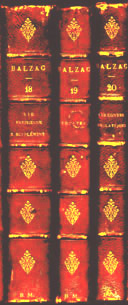 |
The
following texts will be available on reserve and for purchase
in the College Store:
• T.C.W. Blanning, ed., The Nineteenth Century,
Oxford Short History of Europe, ed. Blanning (Oxford: Oxford
University Press, 2000)
• Robert Gildea, Barricades and Borders: Europe
1800-1914, 2nd ed., The Short Oxford History of the Modern
World, ed. J. M. Roberts (Oxford: Oxford University Press,
1996)
• Daniel R. Headrick, When Information Came
of Age: Technologies of Knowledge in the Age of Reason and
Revolution, 1700-1850 (Oxford: Oxford University Press,
2000)
• Heinrich Heine, Poetry and Prose, ed.
Jost Hermand, Robert Holub; intro. Alfred Kazin, The German
Library, ed.
Volkmar Sander, 32
(NY: Continuum, 1982)
• George Sand, Indiana, trans. Sylvia Raphael,
ed. Naomi Schor, World's Classics (Oxford: Oxford University
Press, 2001)
• Carl E. Schorske, Fin-de-Siècle Vienna:
Politics and Culture (NY: Random House, 1981)
• Eugen Weber , France Fin de Siècle
(Cambridge: Harvard University Press, 1988)
Other,
shorter texts will be available on reserve or the web.
|
class
schedule
| *
designates a primary source |
 return to overview
return to overview |
|
Meeting
2: Tuesday,
10 September
A
Dawning Age of Capital; the "Globalization" Process
of the Early Nineteenth Century
Readings
• Robert Gildea, Barricades and Borders: Europe 1800-1914,
2nd ed., The Short Oxford History of the Modern World, ed.
J. M. Roberts (Oxford: Oxford University Press, 1996), chapter
1, "The Quickening Pace," 3-33
• T. C. W. Blanning, ed., The Nineteenth Century,
The Short Oxford History of Europe, ed. Blanning (Oxford:
OUP, 2000), 1-9
Recommended
Try at least to sample the following primary sources, but
only if you have first worked through Gildea and Blanning.
We can in any event examine some of these texts together in
class, in the course of discussion.
*
Thomas Malthus, An Essay on the Principle of Population
[1798; 1803](excerpt;
full
text)
*David Ricardo, "The
Iron Law of Wages" [1817]
*Friedrich List, A National System of Political Economy
[1841] (excerpt;
full text)
* "A Rhinelander" [Karl Marx], "Debates
On the Law On Thefts of Wood," Rheinische Zeitung,
1842
*
Note: Two poems by Heinrich Heine, which we will read
later in the course, deal with some of the issues raised here:
"The Silesian Weavers" and "The Slave Ship,"
in his Poetry and Prose, ed. Jost Hermand, Robert Holub,
The German Library, ed.
Volkmar Sander, 32
(NY: Continuum, 1982), PP. 52-53, 84-93
Video
(in class)
from
subsistence crises to the petroleum age: excerpts from "Feast
and Famine: The Limestone Legacy," and "Coal, Blood,
and Iron," Parts 4-5 of "The Birth of Europe"
(A&E-BBC, 1991)
Study
Guide
The
text here is in many ways rather dense and makes for slow
going. Don't be discouraged! As you will see, Gildea actually
has a good style and sense of humor. In any case, one of the
goals of the course is to teach you to develop strategies
for dealing with works containing a multitude of "facts."
Begin by assuming that both the author and you are talented
and intelligent. He has a point to make and you can grasp
it. What are the principal ideas the author is trying to get
across? How does his evidence support them?
Further
resources:
* The
Corn Law Debate
*
Malthus
on the "Corn Laws" [1814]
*David Ricardo (biographical
thumbnail sketch; works
[will open in PDF format])
•
If you'd like to get a sense of the American experience in
the transitional era between agrarian and industrial economic
orders, visit ("virtually" or in real life), Old
Sturbridge Village, in central Massachusetts: a living-history
museum of rural life circa 1790-1840
*Friedrich Engels, The
Conditions of the Working-Class in England (1845)
•
On the Irish Potato Famine (sites include information on Irish
immigration to the US)
—"Interpreting
the Irish Famine, 1846-1850," from the University
of Virginia
—"The
Great Irish Famine": comprehensive long-term portrait
of Irish social history, from the curriculum guide of the
New Jersey Commission on Holocaust Education
• Explore the history of "The
Industrial Revolution and the Railway System," a
website designed and based on original research by Mount Holyoke
historian Robert Schwartz
|
 return to overview
return to overview |
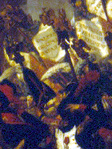 Jacques-Louis
David, Distribution of Eagles by Napoleon
Jacques-Louis
David, Distribution of Eagles by Napoleon |
Meeting
3: Thursday,
12 September
The
Spectre of Revolution and the Ghost of Napoleon
Readings
• Gildea, chapter
2, "Napoleonic Europe," (pp. 34-54)
* Heinrich
Heine, Poetry and Prose, ed. Jost Hermand and Robert
Holub, The German Library, ed.
Volkmar Sander, 32
(NY: Continuum, 1982), Foreword and Introduction (vii-xix),
"The Grenadiers," pp.
2-4
* French Declaration
of the Rights of Man and the Citizen (1789) (from Avalon
Project; Yale)
*
Johann Gottlieb Fichte, "Address
to the German Nation" (1806) (from Fordham)
* Ernst Moritz Arndt, "The
German Fatherland" (from Fordham)
• myths
of identity, from the exhibits in the new German
Historican Museum (Berlin)
Musical
documents (possible selections; in class)
* Robert Schumann (1810-56), setting of Heine's "The
Two Grenadiers" for voice and piano, Romances and
Ballads, op. 49 no. 1 (1840)
Visual resources
•
France in
1789 (by Monin, 1832)
• Central
Europe in 1815 (by Cary)
• political martyrs:
-Louis
XVI and the French royal family (c. 1815-20)
- Napoleon
(early 19th century)
Further
resources:
•
Overview of the history
of the French National Assembly, 1789-present
* The
Decree Abolishing Feudalism, 1789
* The
Civil Constiution of the Clergy, 1790
* Debates in the French National Convention on
the abolition of the monarchy, 1792
* Napoleon's
Account of the Internal Situation of France in 1804
* Napoleonic Code Civil (in
English) (in
French)
Study
Guide
As
you read the assignment, think about the legacy of the Revolution
and Napoleon. For one thing, why does Gildea make this his
next topic? Is it a matter of chronology (the narrative
begins with 1800, after all), or are there other reasons?
What
were the fundamental differences between "Old Regime"
and Revolution? What were the similarities? What is your
impression of Napoleon's character and beliefs? Why was
he such a powerful symbolic figure? After all the upheaval
caused by a generation of revolution and war, just what
had changed?
What was the nature of nationalism? How did it relate to
both Old Regime and new order?
|
 return to overview
return to overview |
 |
 |
 |
|
Prince
Metternich
|
|
Louis-Philippe,
the "Citizen King"
|
|
Meeting
4: Tuesday,
17 September
The
Restoration World (I)
Readings
• Gildea, chapter 3, "Metternich's Europe"
(pp. 55-79)
•
Robert Tombs, "Politics," in Blanning, ed.: just
10-31
* Heine, selections from his his Poetry and Prose:
--"The Silesian Weavers," "Hymn"
("I am the sword, I am the flame"), 52-55
-- Ideas—Book Le Grand, chapters 6-12 (pp.
185-206)
Foundations of the Restoration era:
* Prince Metternich's Political
Confession of Faith (1820)
* French
Constitutional Charter of 1814
(from Napoleonseries)
*
The
French Constitution of 1830 (from
Fordham)
* The
Carlsbad Decrees (1819)(from Hannover)
*
Thomas Babington Macaulay, speech in favor of the Reform
Bill, 1831(excerpt,
from Fordham;full
text, from Birmingham. Note:
read at least the excerpt)
Study
Guide
Let
us extrapolate from the question that we asked in the previous
session. Gildea's first two chapters in essence set forth
the twin forces that served to weaken the old order and
bring about a new one. Just what did the Revolution and
Napoleonic Empire accomplish?
To put the question another way: We tend to speak of a "Restoration"
after 1815. Just what, if anything, was "restored"?
This
period is also the birthplace of our modern notions of liberalism
and conservatism. What do those concepts mean? Where does
nationalism stand in relation to them?
What
was the significance of the Revolution of 1830? Consider,
for example, the changes in French government or constitutions;
unresolved social issues; international repercussions.
Further
Resources
*
French
Press Laws and Ordinances of the Restoration (1819-27)
(from
Napoleonseries)
* Mary Shelley congratulates Lafayette on the results of
the July Revolution, 11 Nov. 1830 (facsimile;
facsimile2;
transcription);
from the Lafayette
Papers in the collections of Cornell University
* Letter from James Madison to Lafayette, 12 Dec. 1830,
on the latter's support for the creation of a new monarchy
(facsimile;
transcription);
from the Lafayette
Papers in the collections of Cornell University
*
Tsar Nicholas I, Imperial
Manifesto on Poland, March 25, 1832 (from Fordham)
*
two American newspaper articles criticizing French persecution
of Polish revolutionaries under the new regime (1833) from
the Lafayette
Papers,
Cornell University
 Gallery: images
of authority and revolution
Gallery: images
of authority and revolution
|
 return to overview
return to overview |
|
|
Heine
as modern political and cultural hero: East
German commemorative
stamp (1972). This depiction empha-sizes
the political radical, reproducing the opening
words of his "Hymn": I am the sword,
I am the flame. (Poetry and Prose, 55)
|
|
Meeting
5: Thursday,
19 September
Romanticism
and its Critics
Readings
•
Gildea, Chapter 5, "Hierarchies of Culture" (pp.
126-34)
• James Sheehan, "Culture," in Blanning,
ed.: just 126-30
*Heine, selections from his Poetry and Prose:
--Alfred Kazin, Foreword; Jost Hermand, Introduction, vii-xix
-- "The Harz Journey": concentrate on pp. 115-19,
126-30, 140-59, 168-73;
--selected poems:
the early love poems on pp. 5-13; middle poems, 23-27; "Course
of the World," "Retrospective," and "Cooling
Off," 75-79; "Forget the holy parables,"
"How slow is time," "I'm not allured,"
95-99; "Song of Songs" and "Lotus Blossum,"
107-11;
Recommended
Concentrate
on working through Gildea and Heine in detail. If you have
time, however, at least sample the following fundamental
manifestos of Romanticism:
*William
Wordsworth, Preface
to the Second Edition of the "Lyrical Ballads"
(from UPenn)
*Victor Hugo, Preface
to Cromwell,(from bartleby.com)
*Heine,
--"The Gods of Greece," "Enfant Perdu,"
"The Slave-Ship," "The Wander-Rats,"
15-21, 83-93, 103-7
--time and interest permitting,
examine the previously unassigned portions of Book Le
Grand
in
class: musical examples:
settings
of Heine's poetry from Schumann's
song cycle, "Dichterliebe" (Poet's Love),
1840
Study
Guide
Of
all the cultural movements of modern Europe, Romanticism
may be the most difficult to define. It aroused strong passions
among both adherents and opponents. Although it at times
assumed the air of an exclusive cult, it also made universal
claims and was not averse to being all things to all people.
Part of the problem derives from the fact that Romanticism
(not unlike the Reformation) unfolded in several phases
and assumed different forms in different countries. What
grounds do we have for calling it a unified movement or
phenomenon? Why (to use Gildea's terms) was aesthetic revolt
such a popular tendency?
(Note: I find Gildea's description of the origins of German
Romanticism somewhat questionable in its details, but his
general assessment can serve as a useful point of departure
for our discussions.)
What
does Alfred Kazin (Foreword, vii-viii) mean when he says
that Heine has not been considered sufficiently "modern"?
Is Heine old-fashioned? Too modern? To what extent does
Heine preserve the values and conventions of Romanticism?
To what extent does he mock or subvert them?
How do Heine's views and poetics compare with those of Coleridge
and Hugo?
|
 return to overview
return to overview |
|
Sunday,
22 September
8:30 p.m., FPH 101

Video screening
"Waterloo"
(Italian-Russian; 1970)
The film depicts Napoleon's career from his abdication and
exile in 1814 through the "Hundred Days" and his
defeat at Waterloo. It places particular emphasis on the character
and personalities of Napoleon and Wellington. Among the notable
features of the production are the extended epic battle scenes,
which effectively convey both the spectacle and the horror
of early modern warfare.
|
|
|
Between
controversy and canon. Heine's
grave in its second form (Montmartre cemetery,
Paris) as pilgrimage site.
|
|
Meeting
6: Tuesday,
24 September
Poetic
Masterpiece and Poetic Engagement
Readings
[NOTE: continue discussion
of Heine from last time: "Harzereise" and "Le
Grand" ]
*Heine, "The Message," and the verse epic, "Germany:
A Winter's Tale" in his Poetry and Prose, pp.
47-49, 231-97
• NOTE: As an aid to preparation, identify
at least 4 passages (stanzas or other sections, however
you wish to define them) in the "Winter's Tale"
that particularly caught your attention. Bring to
class a list indicating, in several sentences or a paragraph
each, which passages you chose, and why. Turn in your responses
at the end of class.
Recommended
(but only if you've had time to work through Heine properly)
skim Gildea, 105, 107-10, 113-22 (Note: We will in
any case return to this material later in the term.)
Study
Guide
As
Jost Hermand observes in the introduction to the Poetry
and Prose (p. xviii), the "Winter's Tale"
is Heines's "poetic masterpiece," "journalism
and poetry, politics and fiction, detached irony and unrestrained
involvement all at once." One could also see it as
extended commentary on the issues raised in our historical
text. Proposition: Heine is offering a critique of precisely
the sort of disciplined society that Gildea describes. Not
only that: Heine is at the same time attacking those of
his fellow-critics of that society whom he regards as inferior
poets and intellects.
Heine's
poem is on one level very accessible because of the power
of its imagery and argument. On another level, it is very
difficult because the specific references will be obscure
to the modern reader. It is unfortunate that our edition
contains no annotations. I will do my best to explain the
references and allusions in the course of discussion. (It
just requires time.)
Further
resources
•
|
 return to overview
return to overview |
|
Meeting
7: Thursday,
26 September
[NOTE: continue discussion
of Heine]
|
 return to overview
return to overview |
|
Meeting
8: Tuesday,
30 September
1848:
Marianne Returns to the Barricades
Readings
•
Gildea, Chapter 4, "The Revolutions of 1848"
• Colin Heywood, sections of "Society" on
liberalism and conservatism, in Blanning, ed., 47-61, 70-77
*François Guizot on the Condition
of the July Monarchy, 1830-1848
*Alexis de Tocqueville on the February
Days
* Documents
of the Revolution of 1848 in France
*
Heinrich Heine, "October 1849," in his Poetry
and Prose, pp. 79-83* Carl
Schurz recalls the outbreak of revolution. From the
reminiscences of the German revolutionary (1829-1906) who
went on to immigrate to the United States, where he served
as an officer in the Union Army, a senator from Missouri,
and Secretary of the Interior.
* Frantisek
Palack´y to the Frankfurt Parliament (1848)
* Johann Gustav Droysen and Friedrich Wilhelm IV on the
question
of monarchy in 1848-49 (two brief paragraphs)
* Sandor Petöfi, "The
National Song of Hungary" (from HNet)
 Gallery:
View Representations
of Authority and Revolution, Circa 1848 Gallery:
View Representations
of Authority and Revolution, Circa 1848
Recommended
*
At least take a look at the Introduction and Part I of Karl
Marx's "Class
Struggles in France"
* Although the "Communist Manifesto" is perhaps
the most famous document to come out of the upheavals of
1848, it had little influence at the time. We cannot devote
our detailed attention to the work, but if you have never
read this fundamental text, you should now at least examine
portions of it. Consider, for example, the following aspects:
the elucidation of a theory of history; the assessment of
the historical role of the bourgeoisie.
—English
version. From the Marx-Engels Internet Archive. This
site will also provide you with access
to Marx's other writings on the events of 1848-49.
—German
version.
Resources on the 150th
anniversary of the Manifesto.
Study
Guide
How
do you account for the wave of simultaneous revolutions
that Gildea, like many other commentators, calls the greatest
such phenonmenon prior to 1989? In 1989, for example, the
countries of the Eastern Bloc revolted against a common
political system.
What does Marx mean when he
says that the defeat of the revolution was really the defeat
of "prerevolutionary traditional appendages"?
that the main achievement of the revolution was "the
creation of a powerful, united counterrevolution"?
(Introduction, "Class Struggles in France"; see
also his remarks at the
end of Part I).
Much
of the popular and scholarly literature alike has tended
to view the revolutions through the lense of contemporary
political interests. Accordingly, the picture has looked
very different at different points in history: for example,
after the creation of new so-called successor states at
the end of World War I, in the aftermath of the Nazi conflagration,
and after the fall of communism.
A
standard view on the left (beginning with such figures as
Marx and Heine) has been that the German revolutionaries,
in particular, were too moderate or lost their nerve. The
issue has been particularly contentious in light of subsequent
developments and the resultant theory of a supposed German
"separate path of development" and lack of democratic
tradition. Indeed, on every front, the authorities made
concessions or capitulated. And yet, by 1849, revolution
had decisively ended everywhere on the continent. What happened?
To
what extent do ideology and external circumstances play
determining roles? Is it true, for example,
that the failure of the revolutions in effect discredited
all political ideologies and left the lesson that only force
mattered in society? Can we say that the middle classes
simply traded freedom for security in order to blunt the
threat from below?
What were the roles of class and nation in these revolutions?
At first sight, one might expect to find a simple opposition
between nationalities struggling for self-determination,
on the one hand, and oppressive, antiquated empires, on
the other. One might also expect that a movement of national
unification would have sought to include all German-speakers
in a common state. As our readings show, the situation was
rather more complicated. What was going on?
More
generally, how do we define a revolutionary movement? Is
there a general standard here? For example, should we take
the French case as the norm? Or do local conditions play
a larger role? How do we assess the success or failure of
a revolution? Are we talking here about a series of distinct
national revolutions or a common phenomenon?
Tip:
Keeping all the events and personalities straight can be
a difficult task. You may find it helpful to consult the
following resources:
• Biographical Dictionary of Major Figures (e.g., Marx,
Mazzini, Palack´y,
Thiers, Kossuth) in Gildea, pp. 459-68
• Chronology
of 1848 Revolutions (a very brief overview, from University
College, London)
• map of the German
Confederation in 1848 (from 1848 Flugschriften im Netz)
further
resources
•
Encyclopedia
of 1848 Revolutions (from Ohio State University)
* Bibliography
of pamphlets and periodicals of the French Revolution of
1848 (from the ARTFL project at the University of Chicago):
facsimiles of original documents (NB in French).
Great research tool for projects. Even if you can't read
the language, you may find useful images.
*
1848
Flugschriften im Netz (from the University of Frankfurt
am Main): German pamphlets, broadsides, posters, and other
print ephemera of the Revolution. Includes serachable list
of individuals, biographical sketches, other resources.
(NB: in German). Equivalent
to the collection of French pamphlets and journals listed
above. Great research tool for projects. Even if you can't
read the language, you may find useful images.
•
The
France of Victor Hugo: created by Professor Robert Schwartz
and his students in History 155 at Mount Holyoke College
*
Documents
on Hungary in 1848-1849 (from HNet): (1) Proclamation
of Ferdinand to Jellacic and the Croats (June 1848); (2)
Archduke Stephen to the Hungarian Diet (July 1848); (3)
Hungarian Diet to King Ferdinand (Sept. 1848); (4) Hungarian
Declaration of Independence (April 1849); (5) Kossuth's
letter to the people of the US (1850); Kossuth at a Congressional
Dinner in Washington (1852). Note: Concentrate on
nos. 1, 4. Skim the beginning of 5. Read the rest to the
extent that time permits
|
 return to overview
return to overview |
|
Meeting
9: Thursday,
3 October
Knowledge
and Power (I)
Readings
Daniel
R. Headrick, When Information Came of Age: Technologies
of Knowledge in the Age of Reason and Revolution, 1700-1850
(Oxford: Oxford University Press, 2000),
Preface, Chapters 1-3
Study
Guide
Among
the many issues the book raises: Why did information suddenly
become so important in the 18th and early 19th centuries?
To put it another way, who needed it and who produced it?
Can we relate the desire to organize (and generally, systematize)
information to other trends that we have studied, or was
it rather, just a matter of a need to control the flood
of data?
•
|
|

Sunday,
25 October
8:30 p.m.
FPH 101
"Impromptu"
Fictionalized
treatment of the relations between George Sand and Frédéric
Chopin, Franz Liszt, and Alfred de Musset. Another twentieth-century
take on the lives of avant-garde artists—scandalous
in their day, canonical in ours. Note: You may find it helpful
to review Gildea (133-34) and the chronology of Sand's life
in Indiana (xxvi-xxviii)
|
|
No
class Tuesday, 8 October: Advising-Exam Day (read ahead!)
|
 return to overview
return to overview |
|
Meeting
10: Thursday,
10 October
Knowledge
and Power (II)
Readings
Headrick, Chapters 4-7
Study
Guide
text
to followxx
|
 return to overview
return to overview |
|
No
class Tuesday, 15 October: Fall Break (read ahead!)
|
|
Meeting
11: Thursday,
17 October
"Race,
Gender, and Class?"
Readings
George
Sand, Indiana, trans. Sylvia Raphael, ed. Naomi Schor,
World's Classics (Oxford: Oxford University Press, 2001)
Study
Guide
It
has become such a commonplace to talk of "race, gender,
and class" that it is in turn easy to make fun of the
reduction of the phrase to a mindless mantra (especially
in the case of European history). The present novel is a
work that actually does employ these three fundamental categories
in an integrated interpretation of contemporaneous society.
It was arguably among the first to do so.
Obviously, there is much to talk about here. Even though
we cannot undertake a thoroughgoing literary analysis of
the work, we can respect its literary integrity. Rather
than treating the work as a "mere" document or
description of reality, we can take seriously and interrogate
Sand's notion of realism: "let society be blamed for
its inequalities and fate for its whims. The writer is only
a mirror which reflects them, a machine which traces their
outline" (Preface of 1832; p. 5).
Consider, for example, her frequent references to the concepts
of "law" and "restraint." How
does one judge Sand's view that politics and love are inextricably
intertwined? (see, for example, p. 116, and the editor's
introduction, p. xxi) Can we establish, for example, a parallel
between Raymon's vacillating romantic strategies and his
opportunistic political doctrines?
What
do you make of the critics who accused Sand of "making
unwise attacks on the institution of marriage" (Preface
of 1842, p. 10)? Sand explicitly raises the issue of feminism,
which has until now featured mainly implicitly in our readings.
Like our other readings, though, the novel treats the situation
of women as distinctive but not distinct from the structures
and strictures of society as a whole. Her cause, she says,
"is the cause of half the human race, it is that of
the whole human race; for the distress of women entails
that of men, as the distress of the slave entails that of
the master" (Preface of 1842, p. 13).
resources
* electronic
English-language edition of Indiana, replete
with kitschy turn-of-the-century illustrations (from UPenn)
* text
of Indiana in French (from the Gallica
project of the Bibliothèque Nationale)
• Friends
of George Sand web page (Hofstra U.)
• entry
on George Sand from the Encyclopedia
of 1848 Revolutions (from Ohio State University)
|
 return to overview
return to overview |
|
Meeting
12: Tuesday,
22 October
Becoming
One (I): Nation-Building and External Enemies
Readings
•
Gildea, Chapter 7, "Nationalism and Unification"
(pp. 165-205)
• Paul W. Schroeder, "International politics,
peace, and war, 1815-1914," in Blanning, ed.: just
158-83 for now
* Joseph Mazzini, An Essay On the Duties of Man Addressed
to Workingmen: Chapter
I (pp. 5-14, 18-20), Chapter
V (pp. 57-63) (from Hanover)
* Documents
of Italian Unification, 1846-61 (from Fordham)
* Marx, The
Eighteenth Brumaire of Louis Bonaparte, Preface
of 1869, Parts I, VII
* Count von Beust, "Memoirs
of the Ausgleich, 1867" (from Fordham)
* Otto von Bismarck, Memoirs,
excerpts on the end of the war in 1866 and the beginning
of war in 1870 (from Hanover)
* A
War Correspondent in the Franco-Prussian War, 1870 (from
Fordham)
further
resources (recommended):
*
The
Austrian Constitution of 1867 (from HNet)
* King Victor Immanuel, Address
to Parliament, 1871 (from Fordham)
* map
of Franco-Prussian campaigns
Study
Guide
Why
was revolution defeated across Europe? What does Gildea
mean by the triumph of "reaction": Was this an
attempt to turn the clock back, or were there modern features
to the new repressive regimes? To put the question another
way, is it safe to say that nationalism proved more attractive
than liberalism or political movements further to the left?
Can we discern different types of generic nationalism?
Did the national unification processes in the various countries
follow similar patterns?
As for the results, would it be fair to extend Marx's generalization
about France under Napoleon III (Eighteenth Brumaire,
Pt. VI): namely, that "Industry and commerce, hence
the business affairs of the middle class, are to prosper
in hothouse fashion under the strong government"?
|
assignment:
prepare for midterm essay (30 Oct.,
with option of extension to 4 Nov.)
|
 return to overview
return to overview |
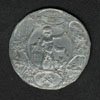 new
prosperity and confidence: medal
celebrating Viennese economic, technological, and
cultural achievement at mid-century
new
prosperity and confidence: medal
celebrating Viennese economic, technological, and
cultural achievement at mid-century |
Meeting
13: Thursday,
24 October
Building
on Profits
Readings
• Carl
E. Schorske, Introduction (skim) and "The Ringstrasse,
Its Critics, and the Birth of Urban Modernism," in
his Fin-de-Siècle Vienna: Politics and Culture
(NY: Random House, 1981), pp. xvii-xxx, 24-115
• Gildea, Chapter 6, "Mid-Century Prosperity"
(pp. 137-64)
(skim; devote particular attention to 137-48, 154-58, 160-64)
• Niall Ferguson,"The European economy, 1815-1914,"
in Blanning, ed.: just 78-84, 89-96, 102-4 (more if you
wish or can, of course)
Study
Guide
We
are here taking something of a leap, or at least a more
extended chronological exploration (we'll look ahead to
the end of the century).
If
population growth, urbanization, and faster communication
were eroding the foundations of the old social and cultural
order, how did cities and their place in society change?
(Note, by the way, that cities cannot be considered in isolation
from the surrounding countryside.) To what extent did political
vs. aesthetic considerations shape urban planning?
Hint:
We'll start our discussion with Gildea and Ferguson and
then move on to a more detailed discussion of Schorske's
essay (which is long but also contains many illustrations).
The chapters from Gildea and Ferguson are rich in detail,
but you should by now be getting a feel for what is essential.
I've tried to suggest some emphases above. Consider, in
addition: The period between the suppression of the 1848
revolutions and the Great Depression of 1873 was one of
unprecedented economic growth. What were the bases of this
expansion? Who were the "winners" and "losers"?
(Incidentally, you may wish to consider some of the phenomena
in light of today's debates over free trade and globalization;
see, e.g., Gildea, 144-48, Ferguson, 82-84) Was this just
a case of new growth, or had something fundamental changed?
Consider, for example, the roles of technology and finance.
Why do historians speak of a "Second Industrial Revolution"
in this era? Think back to the material covered at the start
of the course.
We have hitherto drawn our reading material from Gildea's
synthetic history and numerous primary sources. Schorske's
book enables us to see an intellectual historian turning
to topics in greater detail. What is Schorske's method?
For example, what does he mean when he takes issue with
historians "content to use artifacts of high culture
as mere illustrative reflections of political or social
developments, or to relativize them to ideology"? (xxi)
Why does Schorske place such emphasis on liberalism and
its critics? (Hint: review Gildea on the Compromise of 1867,
pp. 200-5, if you feel the need.) What does he mean when
he argues that modernist culture:
(a) seems hopelessly fragmented, because the old "sweeping
descriptive categories"—"rationalism and
romanticism, individualism and socialism, realism and naturalism"
(with which, we, too, have so far been working in this course)—now
lose their power? (xix)
(b) was born in a "hothouse, with political crisis
providing the heat"? (xxvii)
Why
was the issue of historicist culture suddenly so charged?
How and why did an urban development zone—the "Ringstraße"—come
to stand for an era in the same way as such terms as "Victorian"
or "Gründerzeit"?
Hint:
You should be able to figure out how to read Schorske efficiently
(in the case of the dense later portions of the chapter,
for example). Above all, just be sure that you understand
the nature of the debate over development and historical
vs. modern styles. Similarly, you need not absorb every
detail about every architect and thinker, but you should
at least be able to identify the fundamental beliefs of
figures such as Sitte and Wagner.
In the course of discussion, I'll introduce some additional
material on European cities other than Vienna.
further
resources
• Georges
Haussmann : descriptions and images of the rebuilding
of Paris under Napoleon III
• the
Champs Elysées: the main artery of the new Paris
(official site; many pictures and short captions; longer
descriptions in French)
• The
History of Vienna (from the City of Vienna)
• Earlier
Architecture in Vienna (from the City of Vienna)
•
The
Ringstrasse (Viennaslide Imagefile)
• Photos
of the the Ringstrasse... (from the City of Vienna)
• maps
of fin-de-siècle Vienna, Budapest, Prague (from
this site)
• The
Industrial Revolution and the Railway System: original
research by Mt. Holyoke Professor Robert Schwartz (includes
primary sources)
• Immigration: examine Ellis
Island records
|
 return to overview
return to overview |
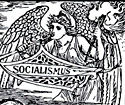 socialist
optimism
socialist
optimism |
Meeting
14: Tuesday,
29 October
Becoming
One (II): Nation-Building and Internal Enemies
Readings
•
Gildea, Chapter 8, "Revolution Contained"
• Ferguson, "European economy," in Blanning,
ed., 85-89, 104-10, 118-25
• Heywood, "Society," in Blanning, ed.,
61-70 (and review 47-50)
* "Inaugural
Address of the International Workingmen's Association,"
London, 1864;[also browse, if you wish, further
history, image, documents] (from the Marx-Engels Internet
Archive)
* Critique
of the Gotha Program, 1875 (from the Marx-Engels Internet
Archive)
* Mikhail Bakunin, "The
State and Marxism," chapter 3 of his Marxism
Freedom and the State (from the Anarchy Archives)
* John Leighton, "One
Day Under the Paris Commune," 1871 (from Fordham)
•
browse some of the materials in The
Siege of Paris: images, posters, periodicals, and other
primary sources
(Northwestern University)
Study
Guide
•
further
resources
*Pierre-Joseph
Proudhon, "What
is Property" (from Virginia Electronic Text Center)
• Social
Democratic Party of Germany
*
International
Workingmen's Association Archive
*
Marx, The
Civil War in France (from
the Marx-Engels Internet Archive)
* The "Sozialistengesetz"
(German antisocialist law) (from documentarchiv.de)
|
 return to overview
return to overview |
kl.jpg) Richard
Wagner:
Richard
Wagner:
"If you honor your German masters, then you will
conjure up good spirits." |
Meeting
15: Thursday,
31 October
Of
Apes and Men (I):
Education, Philistinism, Religion, and the Cult of Art
Readings
• Gildea, Chapter 9, "Mid-Century Culture"
(concentrate on pp. 236-54)
• James J. Sheehan, "Culture," in Blanning,
ed., 126-34, 140-46
* selections from Richard Wagner's prose works:
--selections
from Art
& Revolution (1849): skim the introductory material
to the extent you find necessary, then read pp. 47-57 (scroll
down using the blue numbes in square brackets as your guide).
--selections from The
Art-Work of the Future (1849): I, Parts 3-4,on the
Folk and art; II, Parts 6 (on reuniting the humanistic arts),
IV (outlines of the art of the future)
* Pope Pius IX, Encyclical "Quanta
cura" (Condemning Current Errors) (from The Catholic
Pages)
* Pope Pius IX, "Syllabus
of Errors" (from The Catholic Pages)
* Ernest Renan, The
Life of Jesus (from Internet Infidels)
read chapters 15 ("Commencement of the Legends Concerning
Jesus—His Own Idea of His Supernatural Character"),
26 ("Jesus in the Tomb"), 28 ("Essential
Character of the Work of Jesus").
Time and interest permitting, read around in other parts
of the work. You might wish, for example, to skim parts
of the Introduction, Chapters 1 "(Place of Jesus in
the History of the World"), 2 ("Infancy and Youth
of Jesus—His First Impressions"), and 16 ("Miracles").
*
examination of the popular middle-class periodical, Die
Gartenlaube (in class)
Study
Guide
Why does general education suddenly become so important
in this era? What is meant by the concept of "philistinism"?
What does it mean, for example, to say that the middle class
was educated but not cultivated (Gildea, 241)? Is this portrait
fair? Why were both the right and the left apparently so
bothered by the "intrusion" of commerce into art?
Were their complaints similar? How does one account for
the cult of the artist? This was a time of resurgence of
religion, and yet also a time when religion was under attack
on multiple fronts. What were the issues? How does one draw
up a balance sheet of losses and gains for religion? Can
we connect the renewed debates about art and artists with
religion?
further
resources
•
Multimedia
from Wagner to Virtual Reality (from artmuseum.net)
* Matthew Arnold, Culture
and Anarchy (from UTEL, Univ. of Toronto)
* Pope Pius IX, Encyclical "Ubi
primum" (on the Immaculate Conception) (from The
Catholic Pages)
* Decrees
of Church Councils: see under Vatican I (from The Catholic
Pages)
• 2001—Verdi
in the World (resources for the anniversary year 2000-2001
|
 return to overview
return to overview |
|
Meeting
16: Tuesday,
5 November
Of
Apes and Men (II): Religion, Science, and Social Theory
Readings
• Gildea, Chapter 9, "Mid-Century Culture":
246-59
• Sheehan, "Culture," in Blanning, ed., 134-40,
147-51
* writings of Charles Darwin
* On
the Origin of Species by Means of Natural Selection...
(first edition; from Talk.Origins):
Preface to the third edition
—Introduction (skim);
— Chapter 3, "Struggle for Existence" (read
approximately the first half);
—Chapter 4, (read: opening [approx. first 8 paragraphs;Illustrations
of the action of natural selection; Summary)
—Chapter 6, "Difficulties on Theory" (read:
opening; subsections "On the absence or rarity of transitional
varieties" [skim]; "On the origin and transitions
of organic beings with peculiar habits and structure";
"Organs of extreme perfection and complication";
"Summary")
—Chapter 14, "Recapitulation and Conclusion"
additional electronic versions:
Evolutionary
Classics from University of Bergen
Botany
Online from University of Hamburg
from infidels.org
from human-nature.com
* The Descent of Man:
—Introduction;
—Chapter XXI: "General Summary and Conclusion"
(read at least the opening and concluding pages)
several electronic versions:
Evolutionary
Classics from University of Bergen
Botany
Online
from University of Hamburg
from infidels.org
from human-nature.com
* Friedrich Engels, Speech
at the Grave of Karl Marx, 1883 (from the Marx-Engels
Internet Library)
* Walter Bagehot, "The
Use of Conflict," Chapter 2 of his Physics and
Politics (1869; from Fordham)text
to follow
Study
Guide
•
further
resources
•
The
Talk.Origins Archive: Exploring the Creationism/Evolution
Controversy (resources and mainstream scientific responses
to frequently asked questions about the origins of life
and the world); includes links to creationist sites. Note:
See the welcome
page for information regarding standards of materials
submitted by readers.)
• A counterpart of the preceding is the Discovery
Institute, which seems in many ways to represent the
survival of the Victorian spirit by virtue of its advocacy
of technology, free markets, and religion.
• Evolution,
from University of California Museum of Paleontology
* Ernst Haeckel, "The
Confession of Faith of a Man of Science" (1892)
(from Fordham)
|
|

Sunday,
3November
8:30 p.m.
FPH 101
[Films
on Darwinism and Creationism]
x
|
 return to overview
return to overview |
|
Meeting
17: Thursday,
7 November
Daily
Life and Deadly Dangers
Readings
• Eugen
Weber, France Fin de Siècle (Cambridge: Harvard
University Press, 1988), Introduction, Chapters 1-3 ("Decadence?","Transgressions,"
"How
They Lived"),
1-82
• Ferguson, "European economy," in Blanning,
ed., 104-25 (skim parts you read earlier)
recommended
•
Gildea, Chapter 10, "The Struggle for Economic Supremacy,"
267-99 (as needed)
Study
Guide
•
further
resources
•
|
 return to overview
return to overview |
|
Meeting
18: Tuesday,
12 November
Nation-States
and National Minorities
Readings
• Gildea, Chapter 11 "Problems of National Integration":
pp. 314-19; Chapter 13, "The Management of Society":
pp. 353-56
• Weber, Chapter 6, "A Wolf to All," 130-41
• Schorske, "Politics in a New Key: An Austrian
Trio," 116-80
Study
Guide
•
further
resources
*
overview of and documents on the Dreyfus
Affair (from Georgetown)
* There is no readily available text of the essay on the
nationalities question by the distinguished Austro-Marxist
Otto Bauer, but you can read Lenin's rather dismissive remarks
on "Cultural-National
Autonomy" (1913).
•
More information Bauer and Austro-Marxism from the Bauer
web site
* Theodor Herzl, The
Jewish State, 1896 (from the Jewish Virtual Library).
You might start by examining the introduction and conclusion.
• overview on the centenary
of the publication of Herzl's manifesto, from the Central
Zionist Archives: includes images of manuscript pages
|
 return to overview
return to overview |
|
Meeting
19: Thursday,
14 November
Nation-States,
Manhood, and the "Woman Question"
Readings
• Gildea, Chapter 11 "Problems of National Integration":
pp. 319-25
• Weber, Chapter 4, "Affections and Disaffections,"
83-104
* August Bebel, "Woman
in the Future," from his Woman and Socialism
(1879)
* Alexandra Kollontai, Introduction to the Book, The
Social Basis of the Women's Question, 1908 (from
the Kollontai Archive)
Study
Guide
•
|
 return to overview
return to overview |
|
Meeting
20: Tuesday,
19 November
Discipline
Readings
• Gildea, Chapter 13, "The Management of Society,"
pp. 344-65
• Weber, Chapter 5, "The Endless Crisis,"
pp. 105-29
• Roland Barthes, "The Eiffel Tower," in
his The Eiffel Tower and Other Mythologies, tr. Richard
Howard(NY: Farrar, Straus & Giroux, 1979), pp. 3-17
(reserve)
Study
Guide
•
resources
* Gustave Le Bon, "The
Future of Socialism," Book 6, Chapter 2 of his
The Psychology of Socialism
 Gallery:
The Eiffel Tower (coming)
Gallery:
The Eiffel Tower (coming)
|
 return to overview
return to overview |
|
Meeting
21: Thursday,
21 November
Europe
and Empire
Readings
• Gildea, Chapter 12, "The Race for Empire,"
326-43
• A. G. Hopkins, "Overseas expansion, imperialism,
and empire, 1815-1914," in Blanning, ed., 210-40
• Thomas Babington Macaulay, "Minute
on Indian Education" (1835) (from Univ. of Minnesota)
• "Léopold de Saussure as an Opponent of
Assimilation" (translation from his Psychologie
de la colonisation, 1909), in Imperialism, ed.
Philip D. Curtin, Documentary History of Western Civilization,
ed. Eugene C. Black and Leonard W. Levy (NY: Harper &
Row, 1971), pp. 85-92 (reserve)
• "Jules Harmand on the Morality of Empire and
the Policy of Association" (from Domination et colonisation,
1910), in Curtin, ed., Imperialism, pp. 291-307 (reserve)
Study
Guide
text
to followxx
|
 return to overview
return to overview |
|
Meeting
22: Tuesday,
26 November
Culture
in Transition: Between Mass Entertainment and Modernism
Readings
• Sheehan, "Culture," in Blanning, ed., 152-57
• Weber, Chapter 7, "The Old Arts and the New,"
142-76
• Schorske, "Politics and the Psyche: Schnitzler
and Hofmannsthal," 3-23
Study
Guide
•
|
|
No
class Thursday, 28 November: Thanksgiving Break
|
 return to overview
return to overview |
|
Meeting
23: Tuesday,
3 December
Culture
in Transition: Leisure and Consumption
Readings
• Gildea, Chapter 14, "Culture at the Turn of
the Century": 366-77
• Weber, Chapters 9-11: "Curists and Tourists";
"La Petite Reine"; "Faster, Higher, Stronger,"
177-233
Study
Guide
Was
there something qualitatively new about the rise of "entertainment"
and commercialized leisure activity? Why were both conservatives
and leftists so alarmed by the rise of a new popular culture?
Weber
suggests that the theater was to the fin de siècle
as the film is to the twentieth century. Explore the comparison.
Can we add: as the book was to the early nineteenth century?
Was
tourism exploration, edification, relaxation, or escapism?
If escapism, what were the tourists escaping? Both Gildea
and Weber connect the rise of leisure with the decline of
religiosity, e.g., "In the nineteenth century holy
days turned into holidays" (Weber, 177). What are the
implications of this view?
What does Weber mean when he says, "The very notion
of comfort was a foreign novelty. For the wealthy, luxury
had preceded comfort"?
Was the fin de siècle marked by a new sense of time?
According
to Weber (229), sport and politics were very similar. What
do you make of his analogy?
|
culture
of the body, cultivation of the body as national regeneration
|
|
|
medal
of the Sokol ("falcon") patriotic gymnastic
movement |
| "light
cavalry": humorous view of women cyclists,
Die Jugend, 1899. A mischievous reader
has added a beard and mustache to the face of
one of the women in the larger
image |
|
|
 return to overview
return to overview |
|
Meeting
24: Thursday,
5 December
Science,
Symbols, and the Unconscious
Readings
• Gildea, Chapter 14, "Culture at the Turn of
the Century": pp. 377-88
• Schorske, "Politics and Patricide in Freud's
Interpretation of Dreams" and "Gustav Klimt:
Painting and the Crisis of the Liberal Ego," 181-278
Study
Guide
•
resources:
The first new museum of our new century in New York City
opened in 2001. The Neue
Galerie is dedicated specifically to German and Austrian
art of the period c. 1890-1940.
|
|
Sunday,
8 December
8:30 p.m., FPH 101

Video screening
"Colonel
Redl " (Hungarian-German, 1984; Dir. István
Szabó)
"A sweeping historical epic of power, intrigue, love
and lust set in Austria during the turbulent years before
the start of World War I.
'Colonel Redl' is the story of Alfred Redl, the son of a
poor railway worker who, through driving ambition, became
the head of military intelligence and commander of the 8th
Army in Prague. This drama vividly recreates Redl's life
from his childhood in military school to his mysterious
end amidst rumours of deceit and adultery."
Winner, Jury Prize, Cannes Festival 1985
Although
the film (by the maker's own admission) takes many liberties
with the historical facts of the case, it does so in order
to portray a more general historical truth about the society
and the epoch.
|
 return to overview
return to overview |
|
Meeting
25: Tuesday,
10 December
Apocalypse
Now?
Readings
• Gildea, Chapter 15, "The Break-Up of Nineteenth-Century
Europe," 389-420
• Blanning, Conclusion (241-47)
•
Weber, Chapter 12, "The Best of Times," pp. 234-45
• Schorske, "Explosion in the Garden: Kokoschka
and Schoenberg," pp. 322-64
Study
Guide
Gildea
and Schorske stress the crises and coming disaster during
the fin de siècle. Weber seems to detect a positive
mood: was it illusion? delusion? What is Blanning's view?
Just
how do we draw up a balance sheet for the century?
•
|
 return to overview
return to overview |
|

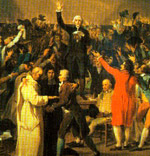
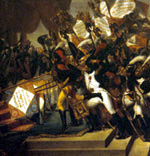
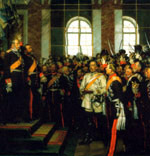

kl.jpg)











kl.jpg)
